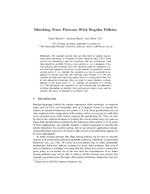LATPub432: Unterschied zwischen den Versionen
Aus International Center for Computational Logic
Marcel Lippmann (Diskussion | Beiträge) KKeine Bearbeitungszusammenfassung |
Marcel Lippmann (Diskussion | Beiträge) KKeine Bearbeitungszusammenfassung |
||
| Zeile 20: | Zeile 20: | ||
}} | }} | ||
{{Publikation Details | {{Publikation Details | ||
|Abstract=We consider policies that are described by regular expressions, | |Abstract=We consider policies that are described by regular expressions, finite automata, or formulae of linear temporal logic (LTL). Such policies are assumed to describe situations that are problematic, and thus should be avoided. Given a trace pattern u, i.e., a sequence of action symbols and variables, were the variables stand for unknown (i.e., not observed) sequences of actions, we ask whether u potentially violates a given policy L, i.e., whether the variables in u can be replaced by sequences of actions such that the resulting trace belongs to L. We also consider the dual case where the regular policy L is supposed to describe all the admissible situations. Here, we want to know whether u always adheres to the given policy L, i.e., whether all instances of u belong to L. We determine the complexity of the violation and the adherence problem, depending on whether trace patterns are linear or not, and on whether the policy is assumed to be fixed or not. | ||
finite automata, or formulae of linear temporal logic (LTL). | |||
Such policies are assumed to describe situations that are problematic, | |||
and thus should be avoided. Given a trace pattern u, i.e., a sequence | |||
of action symbols and variables, were the variables stand for unknown | |||
(i.e., not observed) sequences of actions, we ask whether u potentially | |||
violates a given policy L, i.e., whether the variables in u can be replaced | |||
by sequences of actions such that the resulting trace belongs to L. | |||
We also consider the dual case where the | |||
regular policy L is supposed to describe all the admissible situations. Here, | |||
we want to know whether u always adheres to the given policy L, i.e., whether all | |||
instances of u belong to L. | |||
We determine the complexity of the violation and the adherence problem, depending on | |||
whether trace patterns are linear or not, and on whether the policy | |||
is assumed to be fixed or not. | |||
|ISBN= | |ISBN= | ||
|ISSN= | |ISSN= | ||
| Zeile 56: | Zeile 40: | ||
year = {2009}, | year = {2009}, | ||
} | } | ||
}} | }} | ||
Version vom 23. März 2015, 13:24 Uhr
Matching Trace Patterns with Regular Policies
Franz BaaderFranz Baader, Andreas BauerAndreas Bauer, Alwen TiuAlwen Tiu
Franz Baader, Andreas Bauer, Alwen Tiu
Matching Trace Patterns with Regular Policies
In A.H. Dediu and A.M. Ionescu and C. Martin-Vide, eds., Proceedings of the Third International Conference on Language, and Automata Theory, and Applications (LATA 2009), volume 5457 of Lecture Notes in Artificial Intelligence, 105-116, 2009. Springer
Matching Trace Patterns with Regular Policies
In A.H. Dediu and A.M. Ionescu and C. Martin-Vide, eds., Proceedings of the Third International Conference on Language, and Automata Theory, and Applications (LATA 2009), volume 5457 of Lecture Notes in Artificial Intelligence, 105-116, 2009. Springer
- KurzfassungAbstract
We consider policies that are described by regular expressions, finite automata, or formulae of linear temporal logic (LTL). Such policies are assumed to describe situations that are problematic, and thus should be avoided. Given a trace pattern u, i.e., a sequence of action symbols and variables, were the variables stand for unknown (i.e., not observed) sequences of actions, we ask whether u potentially violates a given policy L, i.e., whether the variables in u can be replaced by sequences of actions such that the resulting trace belongs to L. We also consider the dual case where the regular policy L is supposed to describe all the admissible situations. Here, we want to know whether u always adheres to the given policy L, i.e., whether all instances of u belong to L. We determine the complexity of the violation and the adherence problem, depending on whether trace patterns are linear or not, and on whether the policy is assumed to be fixed or not. - Forschungsgruppe:Research Group: AutomatentheorieAutomata Theory
@inproceedings{ BaBaTiu09,
author = {Franz {Baader} and Andreas {Bauer} and Alwen {Tiu}},
booktitle = {Proceedings of the Third International Conference on Language, and Automata Theory, and Applications {(LATA 2009)}},
editor = {A.H. {Dediu} and A.M. {Ionescu} and C. {Martin-Vide}},
pages = {105--116},
publisher = {Springer-Verlag},
series = {Lecture Notes in Artificial Intelligence},
title = {Matching Trace Patterns with Regular Policies},
volume = {5457},
year = {2009},
}
